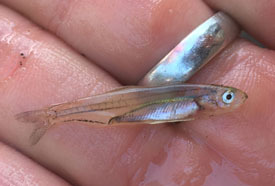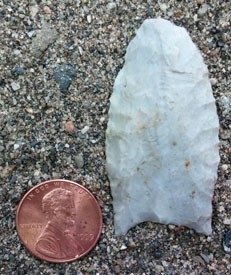Hudson River Almanac 6/10/17 - 6/16/17
The New York State Department of Environmental Conservation sent this bulletin on 06/23/2017 03:14 PM EDT |
| DEC Delivers - Information to keep you connected and informed from the NYS Department of Environmental Conservation |
| Share or view as a web page || Update preferences or unsubscribe |
|
|
It was a good week for bald eagle and great blue heron nestlings against a backdrop of record and near-record high air temperatures. Mystery fishes caught in the East River were finally identified, which only created another mystery of how they got there. HIGHLIGHT OF THE WEEK
NATURAL HISTORY NOTES 6/10 – Newcomb, HRM 302: We have had unseasonably warm weather which, in addition to bringing out hordes of black flies, was also a boon for the butterflies. While I drove to work today, I counted 29 eastern tiger swallowtails (Papilio glaucus) on a 1.5-mile stretch of Route 28N. There are baby bluebirds in the bird box in the garden as well as a young yellow-bellied sapsucker, osprey, and great-blue herons in a marsh nearby. A handful of black fly bites seems a small price to pay when you get to see these wonderful new additions to the landscape. 6/10 – Hudson HRM 118: Heading out of Hudson in Columbia County this evening on Route 9G, I had to slow down for a black bear that was not in a big hurry crossing on the north side of the Roeliff-Jansenkill. 6/11 – Beacon, HRM 61: This was our 33rd year of Hudson River Foundation-sponsored “shad bakes” along the Hudson River featuring smoked and baked fish, discussions on estuarine ecology, and reconnecting people to their river. Our American shad fishery was closed in 2010 due to the effects of over-harvesting; presently a coast-wide species recovery plan is in effect. Twenty-five years ago we used to run 14 shad bakes each spring. As a result of the closure, we now plank (bake on 90-year-old white oak planks) and smoke steelhead (rainbow) trout marinated in several ingredients including Hudson Valley maple syrup. [The Hudson River shad bake has its historical origins in Colonial times. Other than keeping a wary eye for British warships, commercial shad fishing was hardly disrupted by the American Revolution. Europeans had been introduced to American shad by Algonquian people who lived along the estuary. For many millennia, they had celebrated the annual return of shad from the sea by baking fish on huge riverside roasting platforms, some of which were a half-acre in size. Fires, hot coals and cobbles were set around flat rocks upon which shad and other fish were placed for slow cooking and smoking. We have always wondered if they saw this as a festive occasion, with song, dance, and laughter. How could they not? Tom Lake.] 6/12 – Glens Falls, HRM 208: The air temperature reached 92 degrees Fahrenheit today, tying the record high for the date. 6/12 – Albany, HRM 145: The air temperature reached 95 degrees F today, tying the record high for the date. 6/12 – Catskill, HRM 113: At first glance, it appeared to be an acre of disturbed, wind-blown water in the middle of an otherwise low tide calm river off Catskill Point. These were tiny fish, thousands of them – I never got a look at them but the behavior suggested young-of-the-year herring. They might have been this spring’s crop of alewives, blueback herring, or American shad, all struggling with a one-in-a-million chance of survival. From such a sight, it generally follows that something is below them, predators, making them nervous. It could have been any one of several species but a school of small striped bass was the most likely. The quiet air made the 95 degree F temperature, tying the record high for the date, seem even warmer. 6/12 – Esopus, HRM 87: I paddled past bald eagle nest NY384 a half-hour after sunrise and for the first time I saw two nestlings. One of the adults was perched on a branch while both of the young were perched on the edge of the nest on opposite sides 6/12 – Westchester County, HRM 40: In late morning, I spotted a Mississippi kite soaring lazily over Bylane Farm before gliding off to the southwest. It did not look like had any intention of sticking around. [Kites are graceful birds of prey, generally of southern U.S. distribution, falcon-shaped with pointed wings. Roger Tory Peterson.] 6/12 – Bronx, New York City: The air temperature reached 96 degrees F today, establishing a new record high for the date. 6/12 – Manhattan, HRM 1: We checked our collection gear in early afternoon in Hudson River Park at The River Project’s sampling station on the lighthouse tender Lilac at Pier 25. One of our crab pots had a small blue crab (10 mm); in another we found a blackfish, or tautog (275 mm). Our killifish traps had caught an oyster toadfish (95 mm) and a skilletfish (50 mm), as well as mud dog whelk snails, comb jellies, shore shrimp, isopods, and mud crabs. [Blackfish, or tautog (Tautoga onitis), are a saltwater wrasse, a fish of New England waters and the Mid-Atlantic Bight. Their common name as well as species name is derived from an extinct Algonquian language formerly spoken by Narragansett Indians in Rhode Island and vicinity. Their colloquial name, “sheepshead,” speaks to the blocky shape of their head. Tom Lake.] 6/13 – Saratoga County, HRM 182: I was driving along Saratoga Lake in midday and spotted two common loons in breeding colors. Beautiful! 6/13 – Bronx, New York City: The air temperature reached 101 degrees F today, establishing a new record high for the date. 6/14 – Greene County: On my last visit to bald eagle nest NY203 (May 28) I saw two attentive adults and a single nestling. During a late-afternoon paddle today, on a mirror-still Hudson, the nestling was clearly visible together with a sibling – twins! In the short time I watched, I didn't see a feeding, but I did spot one adult on a branch nearby.
6/14 – Yonkers, HRM 18: While collecting water samples from the Saw Mill River for environmental DNA analyses with colleagues from the City University of New York, we encountered a large number of fish in the most downstream pool of the section that had been "day-lighted" (a section of the formerly below street level and covered flow of the Saw Mill has been opened up). The usual suspects were there: about 30 hefty carp and many sunfish. But among them was a sleek-bodied fish, a 16-inch brown trout, right in the heart of downtown Yonkers. [Brown trout (Salmo trutta) are a nonnative fish introduced into North America from Europe in the 1880s. Although they have established spawning populations, they are often stocked in lakes, streams, and reservoirs as a sportfish. Tom Lake.] 6/14 – Manhattan, HRM 1: We checked our collection gear in early afternoon in Hudson River Park at The River Project’s sampling station on the lighthouse tender Lilac at Pier 25. Our crab pots held black-and-white fish! In one crab pot we caught a blackfish or tautog (195 millimeters); in another we found a white perch (185 mm) and two more blackfish (210, 275 mm). A killifish trap caught an oyster toadfish (37.5 mm) as well as more than twenty shore shrimp, ten oyster drills the size of pistachios, over 40 amphipods, a few isopods, mud crabs, a handful of mud dog whelk snails, and seven blue mussels the size of shelled sunflower seeds. 6/15 – Greene County: I paddled over to bald eagle nest NY203 at dusk. It was easy to see the two nestlings, first spotted yesterday. One adult was nearby. Paddling along the shoreline I came upon a second adult. I was happy to see that both adults were on the job. Continuing another few hundred yards, I spotted a dark immature on a very low branch, perhaps only eight feet over the water. Paddling for another hour, I found an adult and an immature sharing a fish on a huge tree root ball, a pair of eagles circling high above, and then an adult pair high in matching dead trees with an immature on the shoreline below them. I had spotted ten bald eagles on my evening kayak paddle. [One of the adults in bald eagle nest NY203 carries a blue DEC band number K96. This eagle was born in a nest (NY12) at Pepacton Reservoir in the Catskill Mountains of Delaware County in April 2000. Tom Lake.] 6/15 – Oscawana, HRM 38.5: I watched from a respectable distance as a doe white-tailed deer and her fawn walked along the low tide Phragmites-fringed mud flats at Oscawana Island Preserve, occasionally stopping to forage in the sediments. [See banner photo of doe white-tailed deer and fawn, courtesy of Vlad Smith,} 6/15 – Poestenkill, HRM 151: In mid-afternoon, Erin Mangene’s trail camera caught an image in her driveway that she believed was a mountain lion (Puma concolor). [This is the second recent mountain lion report: see 6/4 - Greene County]. The rather blurry image showed what appeared to be a large animal with a long tail. The mountain lion is presently considered to be extirpated in New York State. [To be, or not to be ... 6/16 – Ulster County, HRM 85: The nestling from bald eagle nest NY92 was now “branching.” It was perched on one of the limbs holding the nest for a half hour. I have not seen the nestling flap its wings yet, but it already looks larger than the adults and should be flying soon. [As nestlings grow and discover their wings, they find that with vigorous flapping they can gain some rise. From that first lift-off comes the realization that they can move from branch to branch, up and down, or “branching.” Over time this gives them the instinctive confidence that will help them when they take their first real flight. Watching nestlings as they investigate their nest tree reminds me of children at play on the climbing apparatus of modern playgrounds. Tom Lake.] 6/16 – Wallkill River, HRM 77: As I walked along the edge of a fallow cornfield 28 years ago today, listening to the “witchity-witchity-witchity” of a common yellowthroat, I spotted a piece of light gray stone (chert) protruding slightly from a crack in the dry earth. It was the thin edge of a small stone tool, a projectile point, eroded from the soil and staring up at me. I had found a very old Indian artifact, later dated to about 12,000 calendar years ago.
6/16 – Croton Point, HRM 35: A new high count of five purple martins were exploring the new nesting structure at Croton Point. The purple martin (Progne subis) is the largest North American swallow. Here's hoping they nest. This would be the only purple martin colony in Westchester County since the only other known colony, in Rye, lost its housing to Hurricane Sandy. 6/16 – Sleepy Hollow, HRM 28: While taking a break on the banks of the Pocantico River at Philipsburg Manor, I watched all the nesting blackbirds, warblers, and orioles rise up out of the Japanese knotweed and phragmites. They were agitated and making a fuss about something; I figured it was a raccoon or a feral cat on the prowl. Then a mink hopped up into a small mulberry tree and climbed out onto the lower branches as if looking for something, before going back down out of sight. The birds soon relaxed so the mink must have gone on its way. 6/16 – Manhattan, HRM 2: A 6th grade class from the Clinton School for Writers and Artists accompanied us as we checked our sampling gear in mid-morning at The River Project’s Pier 40 research site. Our killifish traps yielded a few shore shrimp and a handful of amphipods and isopods. Then, to our delight, we pulled up a crab pot that held our first adult blue crab of the season, a “jumbo.” Inspection of its abdomen revealed that it was a male. We measured it at 180 millimeters (7-inches) point-to-point across its carapace. [Blue crab (Callinectes sapidus) sizes (carapace width): SUMMER 2017 NATURAL HISTORY PROGRAMS Thursday, July 27: 7:00 PM HUDSON RIVER MILES The Hudson is measured north from Hudson River Mile 0 at the Battery at the southern tip of Manhattan. The George Washington Bridge is at HRM 12, the Tappan Zee 28, Bear Mountain 47, Beacon-Newburgh 62, Mid-Hudson 75, Kingston-Rhinecliff 95, Rip Van Winkle 114, and the Federal Dam at Troy, the head of tidewater, at 153. The tidal section of the Hudson constitutes a bit less than half the total distance – 315 miles – from Lake Tear of the Clouds to the Battery. Entries from points east and west in the watershed reference the corresponding river mile on the mainstem. TO CONTRIBUTE YOUR OBSERVATIONS OR TO SUBSCRIBE Smartphone app available for New York outdoor enthusiasts! Copies of past issues of the Hudson River Almanac, Volumes II-VIII, are available for purchase from the publisher, Purple Mountain Press, (800) 325-2665, or email purple@catskill.net |


 6/11 – Brooklyn, New York City: Two unidentified herring (Clupeidae) wee collected under the Manhattan Bridge in the East River by Isa Del Bello and her staff from the Brooklyn Bridge Park Education Center for the World Science Festival’s Great Fish Count on June 3. Until now, the identity of the fishes was unknown. Today, ichthyologist Bob Schmidt concluded that both of them - 38-39 millimeters [mm] long - were young-of-the-year, one an American shad (Alosa sapidissima) and the others (38 individuals) blueback herring (Alosa aestivalis). The nearest springtime spawning reach for these anadromous herrings is at least 90 miles up the Hudson River. How did they emigrate to the East River so quickly? [Photo of young-of-the-year American shad courtesy of Peter Park.]
6/11 – Brooklyn, New York City: Two unidentified herring (Clupeidae) wee collected under the Manhattan Bridge in the East River by Isa Del Bello and her staff from the Brooklyn Bridge Park Education Center for the World Science Festival’s Great Fish Count on June 3. Until now, the identity of the fishes was unknown. Today, ichthyologist Bob Schmidt concluded that both of them - 38-39 millimeters [mm] long - were young-of-the-year, one an American shad (Alosa sapidissima) and the others (38 individuals) blueback herring (Alosa aestivalis). The nearest springtime spawning reach for these anadromous herrings is at least 90 miles up the Hudson River. How did they emigrate to the East River so quickly? [Photo of young-of-the-year American shad courtesy of Peter Park.] 6/14 – Bedford, HRM 35: The nestling herons at the great blue heron rookery continued to exercise their wings and patiently wait for their next meal to arrive. Most of the nests were left unattended as both parents were away hunting. It takes a lot of food to feed the two-to-four youngsters per nest. The herons appear to have abandoned their attempt at using the nest that had been used earlier this spring by the great horned owls. [Photo of nestling great blue herons courtesy of Jim Steck.]
6/14 – Bedford, HRM 35: The nestling herons at the great blue heron rookery continued to exercise their wings and patiently wait for their next meal to arrive. Most of the nests were left unattended as both parents were away hunting. It takes a lot of food to feed the two-to-four youngsters per nest. The herons appear to have abandoned their attempt at using the nest that had been used earlier this spring by the great horned owls. [Photo of nestling great blue herons courtesy of Jim Steck.] [This stone artifact, a Barnes-type fluted spear point, reminded us of the great time-depth in the Hudson Valley. The style originated in southwestern Ontario and is a diagnostic tool of what archaeologists believe were the first of us, called Paleoindian, to enter the Hudson Valley. The Wallkill River Valley was a seasonal passageway for these Stone Age hunter-gatherers from Ontario, through the Mohawk River Valley, then south through Greene, Ulster, Orange and Rockland counties stopping at stone quarries along the way. They traveled in small bands – families, extended families, perhaps clan related. This stone tool was made from a high quality chert that came from a quarry 55 miles south from where it was found at the lower end of the Wallkill Valley in Sussex County, New Jersey. Tom Lake. Photo of Barnes projectile point courtesy of Tom Lake.]
[This stone artifact, a Barnes-type fluted spear point, reminded us of the great time-depth in the Hudson Valley. The style originated in southwestern Ontario and is a diagnostic tool of what archaeologists believe were the first of us, called Paleoindian, to enter the Hudson Valley. The Wallkill River Valley was a seasonal passageway for these Stone Age hunter-gatherers from Ontario, through the Mohawk River Valley, then south through Greene, Ulster, Orange and Rockland counties stopping at stone quarries along the way. They traveled in small bands – families, extended families, perhaps clan related. This stone tool was made from a high quality chert that came from a quarry 55 miles south from where it was found at the lower end of the Wallkill Valley in Sussex County, New Jersey. Tom Lake. Photo of Barnes projectile point courtesy of Tom Lake.]